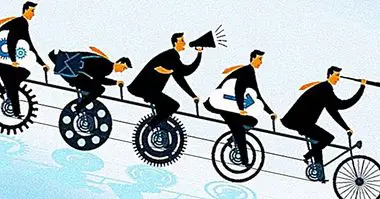Formal leadership: characteristics, advantages and disadvantages
Much of the success or lack of it in a company or team has to do with leadership. This element can make a group of people who before could not coordinate their work to reach a goal, come to work in almost total harmony.
In this article we will deal with The main characteristics of formal leadership , one of the most common types of leadership.
- Maybe you're interested: "Types of Leadership: The 5 most common leader classes"
What is formal leadership?
Formal leadership is based on a leader who has been chosen through a procedure where it is clear that he has the authority to exercise leadership functions over a group of people . There may be leaders in different contexts, such as politics, sports, academics, etc. ...
Formal leaders should have certain personality characteristics that give them ease in managing groups, but that does not always happen that way.
So that you can consider someone as a formal leader It is a requirement that your leadership has not been obtained spontaneously ; If so, then we would be in the presence of an informal leader, who is no more than that individual who plays the role of leader within a social group without any procedure granting him that position.
- Related article: "Useful psychological keys to improve business leadership"
The benefits of this type of leadership
This is a brief summary about the benefits that formal leadership brings to companies and teams.
1. Power assigned externally
This makes it easy for the formal leader to control the members of his team, since they must obey not because they necessarily like to do it, but because it is their duty do what. This benefit is mainly useful when the members of the work team are not familiar with a topic of which the natural leader is an expert.
2. It is based on a practical leader
Bearing in mind that formal leaders usually came to that position thanks to their knowledge and not their ability to please people, it is easier for them to give the orders and take the measures they consider necessary for the best performance of their team , they do not see their judgment very affected by emotions or personal relationships.
3. Greater effectiveness to achieve specific objectives
Groups that have the figure of a formal leader within their ranks tend to achieve a fairly good level of effectiveness, thanks to the degree of control exercised by the formal leader over his subordinates is very high.
Its disadvantages
Not all are positive aspects; formal leadership also has several disadvantages .
1. Level of demotivation in employees
In general, people do not look too motivated when they are forced to perform an activity that they do not like. This usually happens in teams where the figure of the formal leader exists.
2. Communication problems
Speaking the same language does not guarantee a clear understanding . The way in which things communicate is also important. It is common for the formal leader to communicate his wishes in a somewhat dry way, which can generate a conflict so that his message is well received.
3. Greater likelihood of hostile treatment
Although it is not an exact science, there is a greater likelihood of tyranny in work teams based on formal leadership. It may be due to whoever exercises as a formal leader, focuses on the power more than the account and loses sight of the collective objective, waiting for the members of his team to pay him homage.
The differences with natural leadership
The antagonistic term of formal leadership is natural leadership. E occurs when a subject manages to exercise the functions of leader within a certain group of people without the need to have obtained a position through some previous procedure and without the need for an established chain of command.
The natural leader uses his virtue for interpersonal relationships, it is only on the basis of his personality characteristics that he gets others to follow him and take him into account as an authority.
Natural leaders tend to be more empathetic than their counterparts, since the team follows him because of his charisma and not necessarily because of the position he occupies . Since the role of natural leader can be more appreciated, it does not have to be as efficient as the formal leader, taking into account the significant differences in team performance. In the best of cases it can happen that the one who exercises as a formal leader also does it as a natural leader; This scenario would be ideal for any member of a work team.
The characteristics of a formal leader
Next, we will look at the typical behaviors of leaders who embrace formal leadership.
1. Recognition of your role
The intrinsic characteristic that characterizes formal leaders is that his control over the group has been established externally . In this way they are part of the explicit hierarchy of the environment in which they perform. It is common for formal leaders to reach that position based on their academic achievements and experience.
2. Control over the group
The role of formal leader brings with it the ease of command, taking into account that the person holding the position of leader can give direct orders to subordinates, ** without the need to win their affection **.
3. Chain of command
This means that in order for the formal leader figure to exist, there must be a hierarchical order that is responsible for differentiating the different ranges within the environment.
Bibliographic references:
- Nye, J. C. (2011). The qualities of the leader. Barcelona: Paidós.
- Schultz, D. P. Schultz, Sydney E. (2010). Psychology and work today: an introduction to industrial and organizational psychology. Upper Saddle River, N.J .: Prentice Hall. p. 171.



















